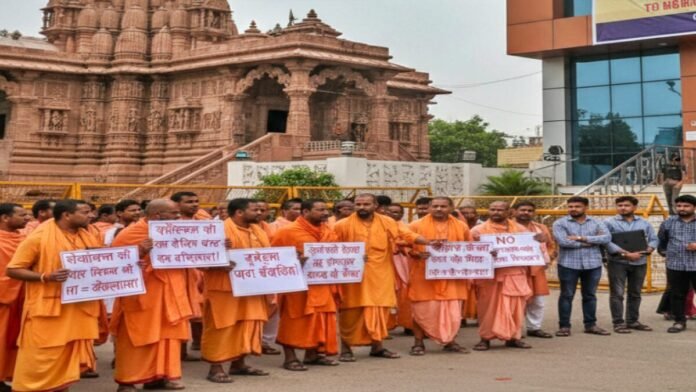
Key Highlights
- Maharashtra government announces ‘Vedic Sanskar Junior Assistant’ short-term course at ITIs, starting in Nashik district
- Course approved under National Skill Qualification Framework (NSQF) to train youth for Kumbh Mela 2026-27 in Nashik
- Minister Mangal Prabhat Lodha announced initiative on October 21, 2025 to create trained manpower for pilgrimage centers
- Trimbakeshwar Temple Trust and local priest organizations strongly oppose the move
- Temple trustee Kailas Ghule calls government’s decision attempt to “commercialize something deeply spiritual”
- Opposition leader Balasaheb Thorat criticizes government for “misplaced priorities” amid farmer distress and unemployment
- Critics raise concerns about non-traditional backgrounds and other faiths entering priesthood through course
- Skill development department defends move as vocational program, not religious study
Nashik: The Maharashtra government has ignited a major controversy by announcing plans to introduce a short-term vocational course titled “Vedic Sanskar Junior Assistant” at Industrial Training Institutes (ITIs), beginning with Nashik district. Skill, Employment, Entrepreneurship, and Innovation Minister Mangal Prabhat Lodha officially unveiled the initiative on Monday, October 21, 2025, stating that the course aims to train youth for service and management roles at pilgrimage sites, particularly during the upcoming Simhastha Kumbh Mela scheduled for Nashik in 2026-27.
According to Lodha, the course has been approved under the National Skill Qualification Framework (NSQF) and will equip participants with practical skills to assist devotees through guidance, hospitality, hygiene awareness, and crowd coordination at major religious gatherings. The training will include instruction in Vedic rituals, mantra recitation, religious ceremonies, and pooja practices, blending technical education with Indian cultural and spiritual knowledge.
“The initiative will not only generate trained manpower for pilgrimage centers but also instill values of discipline and service among the youth,” Lodha stated, emphasizing that the program will play a crucial role when millions of devotees are expected to visit Nashik during the next Kumbh Mela. The government plans to initially launch the course in the Nashik district before expanding it to other regions across Maharashtra.
Religious Community Voices Strong Opposition
The decision has not been well received by sections of the religious community, particularly members of the Trimbakeshwar Temple Trust and local priest organizations, who have voiced sharp criticism of the government’s move. Religious leaders allege that the government launched the course without consulting traditional religious bodies, undermining centuries-old customs and traditions.
Kailas Ghule, a prominent trustee of the Trimbakeshwar Temple, delivered a scathing critique of the initiative: “We have age-old traditions that define the role and conduct of tirth purohits (pilgrimage priests). The government is trying to commercialize something deeply spiritual. Turning this into a professional training programme under ITIs is totally unacceptable. We are completely opposed to this course on ‘Vedic Sanskar’.
Ghule elaborated on his concerns, stating, “Training for priests for the upcoming Kumbh Mela will be provided at an ITI. This is against the customs and traditions of Hinduism. Sanskrit is taught in colleges, but by making it a profession, has the government made an arbitrary decision?” He further questioned whether citizens of other religions would be allowed to enroll and become priests, calling the government’s education system based on a “wrong concept”.
Sacred Lineage vs. Professional Training
The core of the opposition centers on the belief that the priesthood is not merely a profession but a sacred calling rooted in ancestral traditions and spiritual lineage. Local priests argue that the concept of pilgrimage priests (tirth purohits) was established by their ancestors with specific traditions, customs, and prerequisites that cannot be replicated through formal vocational training.
“The concept of priesthood was created by our ancestors. There are traditions and customs for this,” Ghule emphasized. “If our ancestors went on pilgrimage, they would visit a guru there and perform puja rituals. However, the government has introduced such a course, making it a profession. We completely oppose this”.
Critics have labeled the decision “shocking” and inconsistent with Hindu religious traditions, expressing deep concerns that the government’s approach could erode the sanctity of ritual practices by introducing a “professional” class of priests outside the traditional lineage system. They fear that opening priesthood training to anyone through government institutions could fundamentally alter the character and authenticity of religious practices at sacred sites.
Political Opposition Joins Criticism
The controversy has also drawn political criticism, with Opposition leaders questioning the government’s priorities. Senior Congress leader Balasaheb Thorat called the initiative an example of the government’s “misplaced priorities,” arguing that more urgent issues deserve attention.
“There are many important issues the government should be focusing on: farmers’ problems, unemployment, and rising prices. Instead, they are promoting religious courses like ‘Vedic Sanskar’ under the education system, which is very unfortunate,” Thorat stated, highlighting the disconnect between the government’s initiatives and pressing socioeconomic challenges facing Maharashtra.
Government Defends Skill Development Initiative
Officials from the Maharashtra skill development department have defended the decision, clarifying that the course is designed as a skill-oriented vocational program rather than a religious study. They emphasize that the curriculum focuses on practical service management skills needed to handle large crowds at pilgrimage sites, including hospitality, crowd control, hygiene awareness, and devotee assistance.
Department officials pointed to similar initiatives in other states that have successfully combined traditional values with modern service management, arguing that the course represents an innovative approach to vocational training rather than an encroachment on religious traditions. They maintain that the program addresses a genuine need for trained personnel capable of managing the logistical and service challenges posed by massive religious gatherings like the Kumbh Mela, which attracts tens of millions of pilgrims.
Kumbh Mela 2026-27: The Driving Force
The government’s timing for introducing this course is directly linked to preparations for the Simhastha Kumbh Mela scheduled to be held in Nashik during 2026-27. Since Nashik serves as the epicenter for this massive religious festival, which occurs once every twelve years, authorities anticipate an unprecedented influx of devotees requiring extensive support services.
During the Kumbh Mela, thousands of priests are needed to conduct daily religious rituals, worship ceremonies, and guide millions of pilgrims through sacred observances. The government believes that creating a trained workforce through the ITI course will help ensure smooth operations and an enhanced devotee experience during this monumental event.
Debate on Cultural Preservation vs. Vocational Education
The controversy has sparked a broader discussion about the balance between cultural preservation and vocational education, and whether religious themes have an appropriate place within the government’s formal skill development framework. While supporters view the initiative as a pragmatic solution to workforce needs and an effort to preserve traditional knowledge, critics see it as an inappropriate commercialization of sacred practices.
As the debate continues, the initiative remains in limbo, with calls from religious leaders for the government to review and potentially withdraw the decision before implementation. The controversy highlights the complex tensions between modernization, traditional religious authority, and government policy in contemporary India.






















































